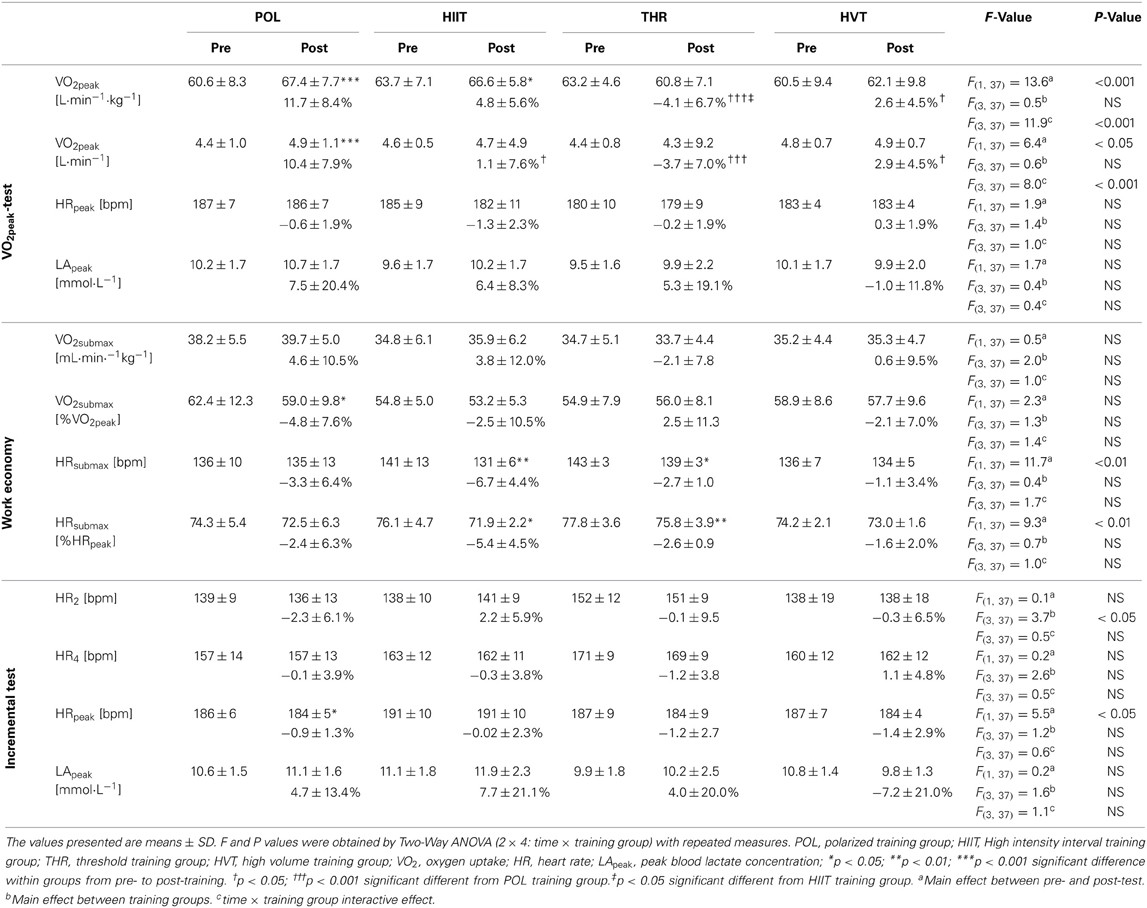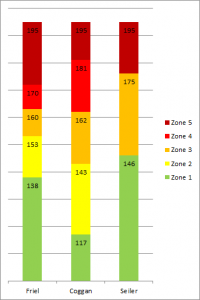Preparing for the Dolomites — Polarized versus Threshold Training
Preparing for the Dolomites — Polarized versus Threshold Training
Right after the hectic time of graduating it is time to focus again on the other things in life. I’m starting a new job soon, but I’m also training for the Giro delle Dolomiti.
Now I have about 4weeks of training left, which is much less than I wanted. The main consequence of the limited time available for training means that I’ll have to train efficiently. Stöggl & Sperlich (2014) convinced me to go for polarized training. In a study they compared polarized training (POL) to high intensity interval training (HIIT), threshold training (THR) and high volume training (HVT). They measured performance change on a number of measures displayed in Table 1. This table shows the different performance measures on the rows, the different methods in the columns, and the pre/post comparison side by side. The table shows that the different methods result in significantly different gains for actually only the heart rate.

So what is polarized training? It is a method developed by Stephen Seiler that consists of, in brief, spending 80% of time in low effort/power/heart rate zones and 20% in extreme effort/power/heart rate zones. Zones are a bit iffy, as several people have developed zone systems. The most notable ones are Coggan and Friel, but the inventor of polarized training (Stephen Seiler) developed his own. Zones in principle are heart rate ranges that correspond to different levels of intensity. Zone 1 corresponds to what you do when you’re moving, but you can still talk, eat, drink, write Medium posts, etc. Zone 5 corresponds when you’re going balls-to-the-wall, everything hurts, I can’t see. And things in between are in between. My zones in the different systems are displayed in Figure 1. These zones are not selected randomly, but they correspond to different ways in which your body creates power. Throughout Zone 1, your muscles burn only fats, and all lactic acid that’s built up as a result can be disposed off. Now there are two main lactate points, the aerobic threshold and the anaerobic threshold. Anything below the former means all lactates can be processed, anything above it means there is build up. Now the anaerobic threshold occurs when there is not enough oxygen to burn the glucose. Lactates build up at a really high rate and within minutes the energy stores are depleted. Now as soon as you go into zone 2, your body starts burning some carbohydrates as well and your muscles create more lactic acid than your body can dispose off, but this pace you can keep up almost indefinitely. Now as you progress through the zones, less fat and more carbs are being burned as fuel and more lactic acid is produced. Zone 4 in Coggan is centered around what is known as the functional threshold heart rate (or FTHR), or the maximum heart rate you can sustain in a full hour maximum effort (Zone 4 in Friel ends at the FTHR). After this FTHR your body solely burns carbs and the lactic acid levels in your blood increase rapidly. One of the reasons we get tired is due to the build up of lactate in the blood. As our muscles work, they release lactates that our body has to process and get rid of.

Now looking back at training, we cyclists like to have the feeling that we work hard. So the natural response is to try and go as fast as possible for as long as possible, which corresponds to cycling around your FTHR. We feel good, because we’re going fast and getting tired. Now Stephen Seiler developed his polarized training system to get the benefits from high intensity training and low intensity training. Training at low intensity is great for your cardiovascular system (your lungs, heart and arteries). Training at high intensity is good to train your body to deal with lactates. Anything in between is a bit of a compromise between the two.
Now I have been trying to do this and it’s hard. When riding a threshold ride you just feel like you’re giving gas all the time. When you do a polarized ride you feel like you’re sitting up 80% of the time and feel like you’re about to cough out your lungs 20% of the time. Right now for me it corresponds to a 35km round, with about 6 2-minute sprints. In Figure 2 are two heart rate distributions, POL on the left, THR on the right. It was for the same lap, but if you look at my average speed, I did 29.3 km/h average in POL and 33 km/h in THR.

So I’m sticking with POL for now. Let’s see if it pays off!
References
Neal, C. M., Hunter, A. M., Brennan, L., O’Sullivan, A., Hamilton, D. L., DeVito, G., & Galloway, S. D. (2012). Six weeks of a polarized training-intensity distribution leads to greater physiological and performance adaptations than a threshold model in trained cyclists. Journal of applied physiology, 114(4), 461–471.
Stöggl, T., & Sperlich, B. (2014). Polarized training has greater impact on key endurance variables than threshold, high intensity, or high volume training. Frontiers in physiology, 5, 33.
Seiler, S. (2010). What is best practice for training intensity and duration distribution in endurance athletes? International journal of sports physiology and performance, 5 3, 276–91.
Leave a Reply